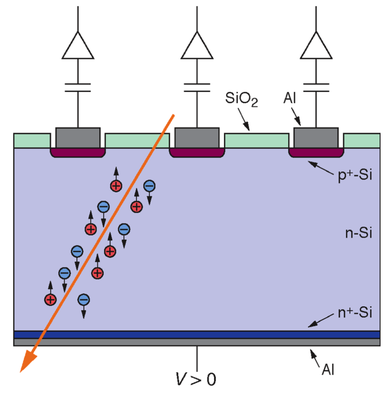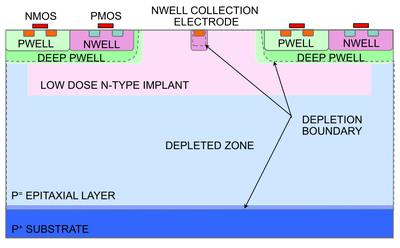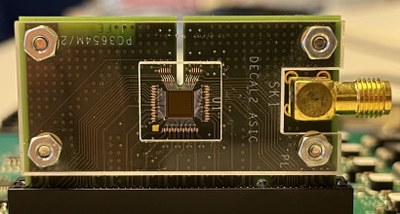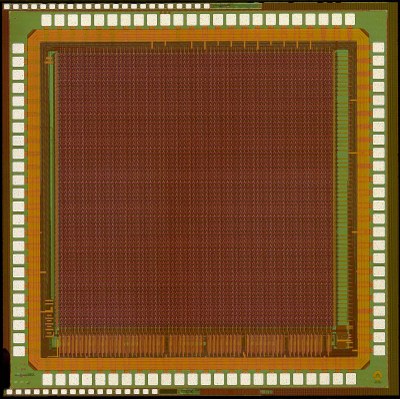Our research today: the DECAL sensor
Silicon sensors, depleted monolithic active pixel sensors
Semiconductor devices are great for particle detection. They are not quite conducting, but only need little excitation energy to create free charge carriers (3.6 eV in silicon). When building a detector, an ultrapure semiconductor material is doped with donor (acceptor) atoms that have an additional (one fewer) electron in their outermost shell (e.g. phosphorus is a donor for silicon). If a donor-doped ("n-type") and acceptor-doped ("p-type") material are brought together and an external bias voltage is applied, the junction is swept from free charge carriers.
The working principle is shown on the left: If a charged particle is traversing the silicon, its energy can excite the silicon, creating free electrons and so-called holes that drift in the electric field of the bias voltage. These electrons and holes can be measured by readout electrodes. Semiconductor devices can be machined very precisely, with a single readout unit (one pixel) being as small as a few micrometers2.


One variant of semiconductor devices is the depleted monolithic active pixel sensors. Similar to modern silicon devices used in cameras and chips, these sensors contain both the complete readout electronics (denoted by NMOS and PMOS in the right sketch, courtesy Nucl. Instrum. Meth. A 871 (2017) 90.) and the active material (the depleted pn-junction where charges can be created). The readout electronics are protected from the excitable silicon through (deep) p- and n-wells. This is a big advantage to the silicon detectors used in most high-energy physics experiments, where the readout and active material are two separate silicon devices that need to be connected through complicated processes such as bump bonding.
Another special feature of the depleted monolithic active pixel sensors is the epitaxial layer, a high-resistivity silicon layer. This layer can be made very thin (tens of micrometres thick) and allows for effective charge creation and collection. Also, only a small bias voltage is needed to deplete the epitaxial layer.
The DECAL sensor
The DECAL sensor is a depleted monolithic active pixel sensor designed for digital calorimetry. The left photo shows the sensor mounted on a test board while the right photo is a close-up picture.


The current sensor is only 5 x 5 mm2 large, a single readout unit (a so-called pixel) has the size of 55 x 55 µm2 and the thickness of the epitaxial layer is 25 µm.
The major novelty of the sensor is its intelligent readout: Instead of reading out single pixels, the sensor measures how many pixels within a group of up to 1024 pixels, have registered a "hit" and only provides that number for the readout. This reduces the data volume such that one is able to obtain information on how many particles were in a particle shower for every collision at modern particle colliders (which happens for example every 25 ns at the LHC). Thus the DECAL sensor enables the possibility to build a digital calorimeter based on silicon detectors.
